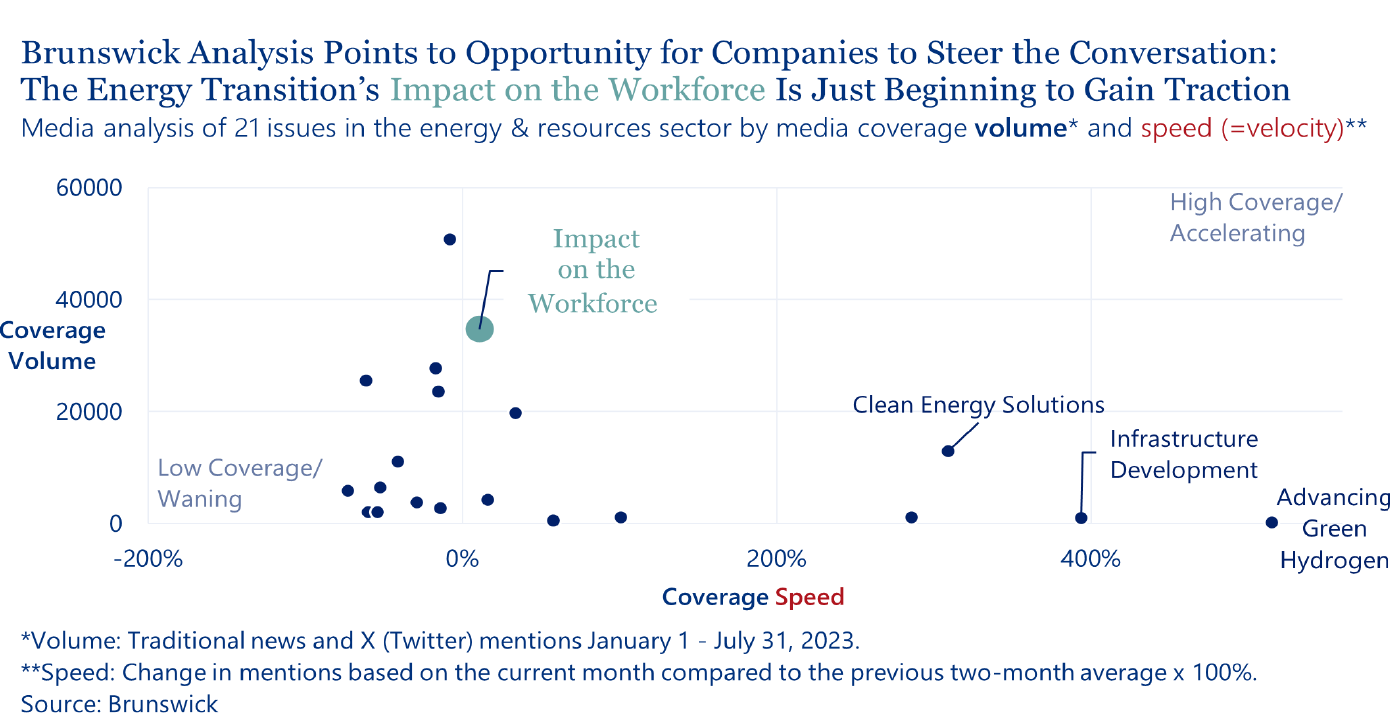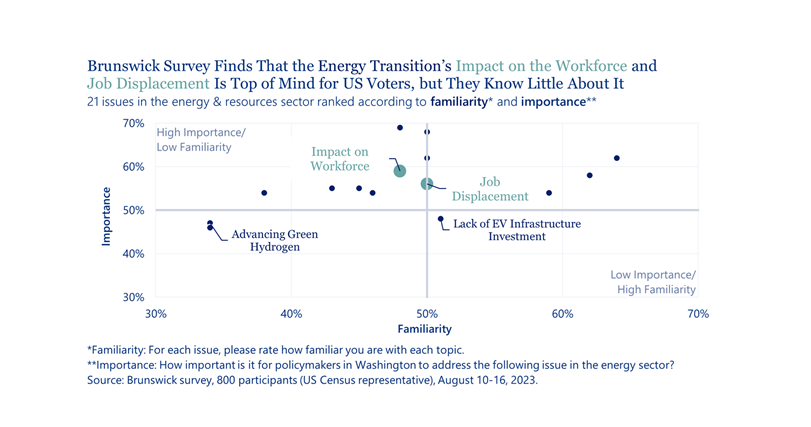
The energy transition’s impact on the workforce is just at the beginning of gaining traction.
The extractives must rise to the challenge of communicating with the next generation of employees. Current numbers aren’t looking great – data from Bloomberg’s latest annual ranking of America’s top business schools show that less than 2% of MBAs are going into the energy industry.
Brunswick Director and Energy & Resources Sector Manager Emily Buczynski spoke about effective partnerships between industry and higher education institutions and about how industry can improve its narrative with two education experts: John Butler, Academic Director at the Kay Bailey Hutchison Energy Center at the University of Texas at Austin McCombs School of Business; and Michael Schoenfeld, Brunswick Partner, co-head of the firm’s foundations, education and global health sector, and former Chief Communications Officer and VP of Public Affairs at Duke University.
How did the current narrative on the extractives get to where it is? Can it be reframed?
John Butler [JB]: I’ve been at industry presentations where the rhetoric comes off as defensive – students don’t like that. I’d encourage industry to be honest. They should present the energy transition as complicated but solvable and highlight the important role the extractive industries must continue to play. Present the facts; don’t be defensive as it will come off as inauthentic.
There was a big controversy in the early 2010s when an oil and gas company wouldn’t release the formula for their fracking fluid – they saw it as protecting proprietary information, but it came off as suspicious. If they had just been transparent, it could have headed off some drama.
Michael Schoenfeld [MS]: Universities like Stanford, Duke, Michigan and others are making multibillion-dollar investments in clean energy research and education initiatives. This is an in-demand field just for students and faculty. Employers may want to position themselves with a longer view and look at the preparation for a clean energy future. For example, the manufacturing of solar panels and EVs uses materials and processes that, for the moment, require some amount of petroleum products.
This is a story that could be told more creatively. Some assume that we will go from putting gas in a car to charging it in front of a house without additional innovation, infrastructure, and resources that energy companies can create. There will be opportunities for companies to make a case that new graduates can be part of the solution rather than the problem. It’s a challenging and difficult story to tell in this political environment – but it’s important to tell it accurately and honestly.
How can the extractives more effectively communicate the message of “come work with us and help us make the world a better place”?
JB: Energy companies, in particular, have two big problems: They’re energy companies, and they’re big. Today’s college students generally don’t seem to want to work for big companies. Many are seeking their perfect job right off the bat, rather than seeing the longer path as the way to land their ideal end job. I’d encourage companies to talk to students about all the opportunities they would have access to once they’re inside the organization. For example, many of the big players have some sort of clean solutions group. And tech has created so much value in oil and gas. It may seem hard to make industry sound cool, but we can do a lot more to talk about all of the tech innovations happening in the industry and how they are helping to drive positive change and support the energy transition over the coming decades.
MS: This is a generation motivated by transparency. They are sophisticated in dissecting arguments and marketing slogans; they are interested in authenticity. Don’t try to pretend you’re something that you’re not. Be as authentic and as transparent and as honest as you can be in talking to these younger audiences.
Build an aspirational story about creating the infrastructure for the future, and the way we’re going to build it is to invest in the kinds of things that are necessary, and it can take decades. Use the same creativity that went into creating the evolution of the petroleum-based economy and that will be needed to create the future.
When industry comes to speak to students on campus, are they sending the right person? Sharing the right message?
JB: If all students hear is that these are dying industries, they won’t study anything related to them. We need people from industry across the value chain to show students that that their studies – regardless of major – are relevant. We need to share concrete examples of how students can apply their experience to opportunities across the extractive industry. We are going to need a broad array of talent – and a broad array of energy sources – as we navigate the transition.
I went to an industry event on campus where the company wanted to hire our students, and at the end of the event they gave them something to take home. It was a pencil that had a seed pod at the end instead of an eraser. The idea was that they’d bury the pencil when they were done with it and a plant would grow. Students don’t use pencils. They didn’t get it. That was definitely an opportunity for that company’s messaging to be more on point.
MS: Industry needs to be thinking more about peer-to-peer versus the executive in the suit. Young people today are highly networked among each other. They live in decentralized environments. They don’t respond to central control. There is likely nothing more hierarchical in their imaginations than a petroleum company – so look for ways to engage where they are, not where you wish they were. Encourage peer-to-peer networking among people who understand the environment the students are entering and who can speak their language of innovation and mission. Trust in institutions is at an all-time low and dropping. Students relate to their peers and people who have shared similar experiences to them.
How is the KBH Energy Center helping to connect students to industry?
JB: A lot of students aren’t clear about the interrelationships between issues and the continued need for hydrocarbons in the future energy mix; we can’t just flip a switch and create a new energy system. We try to create a big, open tent, where we’re looking to inform decision-makers, not trying to change anyone’s mind. We want to be conveners and a source of information for students about the tradeoffs in the energy mix of the future.
Download a copy of this report here.


